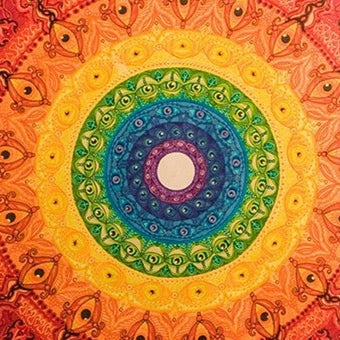The relationship between the chakras and the awakening of consciousness
According to the Vedanta and Yoga-Samkhya traditions, the human being is composed of three distinct bodies (physical, subtle, and causal), overlaid with five sheaths, among which we highlight the pranamaya kosha, sustained by prana, the universal energy present in everything, which we work with in yoga through pranayama techniques.

(The equivalence between bodies, sheaths, and planes in Vedanta / Yoga)
From the Tantra perspective, the explanation of the energetic-psychic functioning in the human being is completed through the chakras (= disks, circles... as they are visualized in meditation) and the nadis, which are worked on particularly through practices from kriya-yoga, with the ultimate goal of facilitating the ascent of the kundalini

(The location of the main chakras. Source: Kundalini Tantra)
When speaking of nadis, we refer to the psychic channels through which energy flows in the human body, while the chakras (mooladhara, swadhisthana, manipura, anahata, vishuddhi, ajña, bindu, sahasrara) generate, accumulate, and transform that energy to exchange it between the physical, subtle, and causal bodies.
It is through the chakras that prana is transformed into both vital energy for the physical body and psychic energy for the subtle and causal bodies.
The main chakras are located in the physical body, connected to the brain and positioned along the spinal column (though they have kshetrams*, projections on the skin). They are associated with nerve plexuses or endocrine glands and are fundamental elements of the subtle body, serving as gateways for exchange between the human being and the universe.
Generally, we activate the chakras through energetic pathways, directing attention to their location (and repeating their beeja mantra), which generates a pranic current toward their position. This transforms into energy and activates the psychic center, enhancing its activity.
| Chakra | Beeja mantra |
| Mooladhara | Lam |
| Swashisthana | Vam |
| Manipura | Ram |
| Anahata | Yam |
| Vishuddhi | Ham |
| Ajña | Om |
| Sahasrara | no tiene |
Since each chakra is connected to the brain, its activation produces an increase in the level of consciousness of that part of the brain, which is why we speak of awakening.
As each chakra is activated, from the lower ones with more instinctive aspects to the upper ones with a more intuitive nature, you access higher levels of consciousness. This is where Yogananda speaks of two switches or knots, referring to the Vishnu Granthi (anahata area) and the Rudra Granthi (ajña area where difficulties arise, either due to attachment to people and actions, or to the individual or the ego).
When the chakras awaken, the mind changes and spiritual progress occurs, developing higher qualities such as love, compassion, mercy, etc.
*Not officially considered chakras.
**All except mooladhara and sahasrara

